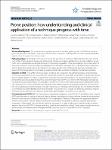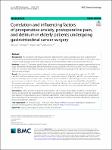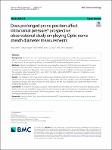Search
Search Results
Two of the hottest research topics today are hybrid nanomaterials and flexible electronics. As such, this book covers both topics with chapters written by experts from across the globe. Chapters address hybrid nanomaterials, electronic transport in black phosphorus, three-dimensional nanocarbon hybrids, hybrid ion exchangers, pressure-sensitive adhesives for flexible electronics, simulation and modeling of transistors, smart manufacturing technologies, and inorganic semiconductors. |
The purpose of this special issue is to help better understand how mechatronics will impact on the practice and research of developing advanced techniques to model, control, and optimize complex systems. The special issue presents recent advances in mechatronics and related technologies, including: automatic control, robotics, agent-based systems, smart manufacturing, and Industry 4.0. |
In this book, a variety of topics related to microchips are extensively illustrated. The topics encompass the physics of operation of the microchip device, as well as its design methods and applications |
A collection of readings and exercises aligned with the course, ME 270, Introduction to Mechanical Engineering Design, at Iowa State University. This course provides an overview of mechanical engineering design with applications to thermal and mechanical systems, and an introduction to current design practices used in industry. |
The findings in CT scans enhanced the use of prone position in ARDS patients. The main mechanism of the improved gas exchange seen in the prone position is nowadays attributed to a dorsal ventilatory recruitment, with a substantially unchanged distribution of perfusion. Regardless of the gas exchange, the primary effect of the prone position is a more homogenous distribution of ventilation, stress and strain, with similar size of pulmonary units in dorsal and ventral regions. In contrast, in the supine position the ventral regions are more expanded compared with the dorsal regions, which leads to greater ventral stress and strain, induced by mechanical ventilation. |
Hypothyroidism is a pathological condition related to a deficiency in circulating thyroid-hormone concentrations [1]. Etiologies are mainly autoimmune thyroiditis, iodine deficiency, post-thyroidectomy or pharmacological, and central due to pituitary or hypothalamic disorders [1, 2]. Although the prevalence of overt hypothyroidism is estimated at 1–2% of the general population [3], hypothyroidism may result in a wide range of severity from subclinical hypothyroidism to exceptional life-threatening myxedema coma (MC). |
Preoperative anxiety is a typical emotional issue among surgical patients. Studies have shown that preoperative anxiety affects patients on both a physiological and a psychological level [1]. Surgery and anesthesia are the main factors that contribute to preoperative anxiety. The incidence of preoperative anxiety in Chinese adults is 16.9%, and female gender and highly invasive surgery have been identified as risk factors for high preoperative anxiety [2]. Preoperative anxiety has been shown to play an important role in modulating postoperative pain [3,4,5,6]. The literature and research are based on the theory of a linear rather than curvilinear relationship between anxiety and pain, meaning that with increased anxiety there is an increase in pain [7]. |
Acute respiratory failure (ARF) is defined by acute and progressive hypoxemia caused by various cardiorespiratory or systemic diseases in previously healthy patients. Among ARF, acute respiratory distress syndrome (ARDS) is a serious condition with bilateral lung infiltration, which develops secondary to a variety of underlying conditions, diseases, or injuries. This review summarizes the current standard of care for ARF and ARDS based on current major guidelines in this field. |
Although invasive methods (intraventricular and intraparenchymal monitors) are still the gold standard in the diagnosis and follow-up of increased ICP, these approaches may cause major complications, such as hemorrhage and infection [8]. Non-invasive alternative methods recommended for the assessment of ICP include the following: measurement of changes in cranial computed tomography (CT) and brain magnetic resonance imaging (MRI), transcranial doppler, tympanic membrane displacement, intraocular pressure, venous ophthalmodynamometry and ONSD [8]. |
Anesthesiology and Perioperative Science (APS) is an open access and peer-reviewed journal which publishes high-quality cutting-edge work of all aspects of anesthesiology, perioperative science and beyond. The publication of the first issue of APS represents a milestone of the development in Anesthesiology-based perioperative medicine, which has the scope far beyond the concepts and practices of the traditional anesthesia care of patients. Launching this journal will likely provide the additional vehicle to advance the research and practice of Anesthesiology and Anesthesiology-based perioperative medicine and science. |










